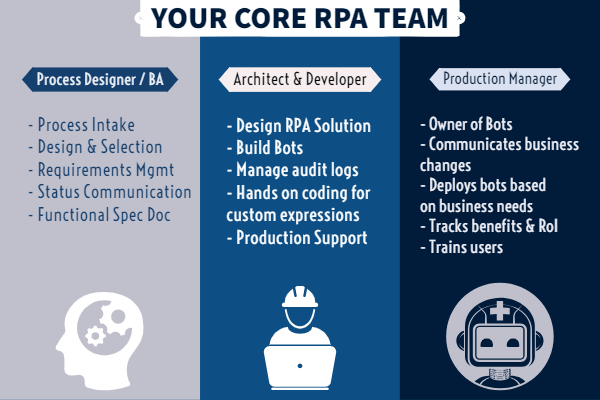As we all know, RPA allows users to automate existing manual processes or create new composite processes.
However, despite RPAs ability to bridge the integration digital divide, it’s an obvious fact that successful projects still require the right people in right places doing the right things right.
So who are these people and what should they be doing to support a successful robotic process automation project?
Roles and responsibilities of an RPA developer team:
- The Process Designer (or) Business Analyst (or) Functional Consultant
- Automation architect (or) Bot Developer
- The Production manager: Biz Ops liaison

Process Designer’s Role
The Process Designer is usually a business user who understands the existing process. The rules and the vision for the design process by this role should be ultimately handled by one person or team for accountability purposes. It is important that the Process Designer works closely with all those who perform the current process in order to accurately capture the nuances of the process. Understanding or incorporating this can make or break the project.
Ultimately the Process Designer needs to learn about and understand a process and then either institutionalize or consolidate them. The Process Designer is the keeper of the specification of the RP project and should be responsible for looping back into the specification, feedback and changes made during the development and testing phase.
The skills to become the Process Designer all stand same for all the companies. But the job description varies from company to company, based on industry? So, basically a process design, his job description could be like something that he should be able to handle projects in any of the tools such Pegasystems, Blue Prism, Automation Anywhere, etc.
That person should have good analytical and problem solving skills so that he or she can communicate well and handle the clients in such a way that the company scales forward.
Also, he should have good knowledge of programming languages such as .NET or Java and also the knowledge of product architecture, implementation and infrastructure requirements.
Heshould have an average of two years of professional experience in programming languages and also SQL and relational databases.He should have good expertise with process analysis, design and implementation. Strong project management skills are a plus too.
Automation Architect’s Role
The automation architect is the person who actually built the automation using the robotic process automation tool. Depending upon the tool used, this role may or may not require developer level expertise. While many RPA vendors vouch to the fact that the automation studios do not require programming expertise. I would say to not believe it because if you’re looking to automate a process that involves rules and logic like most worldwide automation does, then it definitely requires programming.
So whether one is writing syntax of configuring loops and branching it in a case, it is programming and the automation architect should have some experience for it. Somebody with a few years of experience developing automation solutions using robotic process automation platforms or someone with great test automation knowledge will be a plus.
Strong problem solving skills, analytical skills and design skills is a must. Hands on experience with coding languages is a must. An automation architect should be able to design technical specification documents for your project. He should be able to create a complete technical architecture for a project, making sure that the architecture is extensible and scalable. Hands on experience in RPA tools is a plus, but not necessary if they are well versed in programming languages such as Python, VB script, .NET and so on. Whats more the architect in a smaller company should be hands on in production team and participate either as a developer or a UAT tester or even as an implementation person.
Production Manager’s Role
This refers to a person who is responsible for running the bot once the bot is tested and goes live into production. So, the other two roles that is the process design and the automation architecture come before the role of a production manager. The production manager is responsible to ensure that the processes are being triggered. He or she addresses the inline processing port prompts.
A production manager is also responsible for handling process exceptions, reporting back to the automation architect and also reviews analytics and provides process improvement information to the Process Designer. The production manager needs to clearly understand the roles of process designer and automation architect. A person with solution deployment experience is a must.
The production manager should be able to understand the RPA architecture. He or she should have the hands on knowledge of robotic process automation tools. He should have proven experience in innovativeness and ability to integrate disparate technologies.